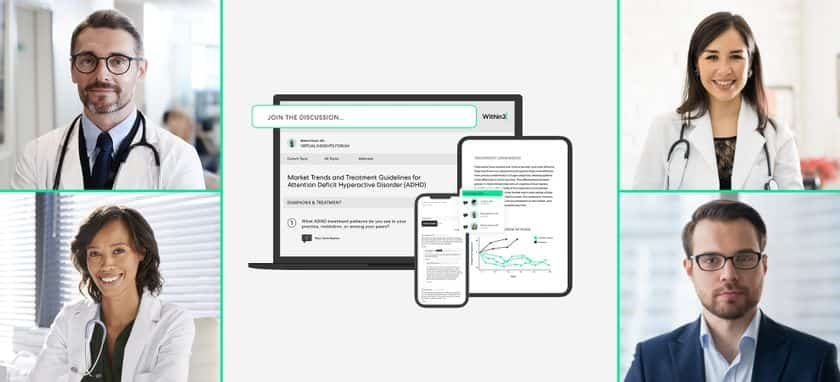Medical affairs teams establish, develop, and strengthen relationships with KOLs to obtain expert insight on important topics. However, this input stream can have another powerful purpose: continuously improving medical affairs KOL engagement. Read on to understand how the level of pharma KOL engagement you have now can improve your future planning, and how a solid digital engagement strategy can help.
What is the role of medical affairs?
Put simply, medical affairs teams are external-facing medical and scientific leaders charged with obtaining scientific and medical information and disseminating that information to healthcare professionals. Medical affairs professionals interpret and contextualize data, generate real-world evidence, engage in peer-to-peer scientific dialogue, and educate clinicians and other decision-makers. These professionals typically have advanced degrees, and therefore speak the same “language” as clinicians.
The responsibilities of medical affairs teams vary by company, but might include:
- Conducting HEOR studies that evaluate the impact of a drug or device on things like medical costs and patient quality of life
- Creating publication plans and preparing scientific presentations at medical congresses
- Supporting HCP in healthcare or internal education programs
- Obtaining market intelligence and sharing it with internal peers and leadership
Whatever the end goal of a particular project, the overarching responsibility of medical affairs is gathering insight from healthcare providers who are leaders in their area of interest, whether that be a specific disease or a broader therapeutic area. These medical affairs KOLs are frequently invited to engage with pharmaceutical or medical device teams to answer questions, contribute to publications, provide feedback on educational materials, offer input on training, or other important projects.
How do KOLs play a role in medical affairs?
The healthcare landscape is ever-changing, and pharmaceutical and medical device companies must evolve their marketing, training, and educational approach accordingly. It’s important to note that a KOL in clinical research will have a very different role than a KOL in medical affairs. When new data is available or new regulations take effect, medical affairs KOLs can be called upon to share input, offering opinions and expertise based on their own knowledge and experience. By virtue of their work with patients and peers, they are uniquely positioned to provide a stream of critical insight to medical affairs professional teams.
Once in possession of this input, a medical affairs team may share it internally, with external HCPs, or even patients and patient advocacy groups. Sometimes, a team may use input gathered from medical affairs KOLs to create patient engagement opportunities to gauge how certain decisions might impact patients’ lives, or use it for MSL engagement and training.
Why is a digital strategy important?
Maintaining and nurturing relationships with key opinion leaders is critical for medical affairs teams who consistently need to gather feedback. Establishing these important relationships through KOL mapping requires a long-term strategy and careful planning, and medical affairs teams must be prepared to course-correct if the needs and wants of KOLs change over time.
KOLs and medical affairs teams alike are eager to engage in ways that don’t add more commitments to already busy schedules. And everyone is more than ready to reduce the hours spent in front of a web camera. Medical affairs teams must consider lessons learned during the pandemic and go forward with a more digital approach, deciding when to engage their KOLs online, when to hold in-person meetings, and when to deploy asynchronous engagements alone or in tandem with live virtual or face-to-face meetings to better streamline KOL management in pharma.
Medical affairs teams can also consider leveraging digital opinion leaders, or DOLs, to diversify their insight-gathering approach. DOLs move in slightly different circles than KOLs and are active on social media and other digital channels, where they can share data and influence prescribers as soon as new information becomes available. DOLs can also act as discussion moderators in asynchronous discussions since they have credibility and are comfortable in a digital environment.
How can medical affairs insights be used to improve KOL engagement?
Continuous improvement of KOL engagement is an important goal, and medical affairs teams can use the work they’re already doing to refine and perfect the process. Here are a few ways teams can get more from their KOL interactions:
- More frequent virtual touchpoints provide more opportunities to learn about KOLs and their areas of specialization, which can help medical affairs teams be more precise in selecting KOLs for various engagements
- By cultivating DOLs, medical affairs teams can diversify their pool of experts and maintain a connection to audiences they might not otherwise reach
- Identify KOLs who seem neutral to negative about certain therapies and probe for more information to learn about barriers to adoption and how to adjust positioning with more data or real-world evidence potentially
- Establishing pools of local, regional, national, or global KOLs
Medical affairs teams can benefit from a virtual engagement strategy that sustains and strengthens relationships with KOLs, and medical affairs KOL engagement provides many opportunities for life science teams to examine their KOL strategy and make adjustments to be more precise and to gather insights that enable faster, more data-driven decisions. Using a comprehensive virtual advisory board that yields more actionable insights and provides KOLs with a way to stay connected and share their expertise adds efficiency, effectiveness, and value to all types of KOL engagements.







